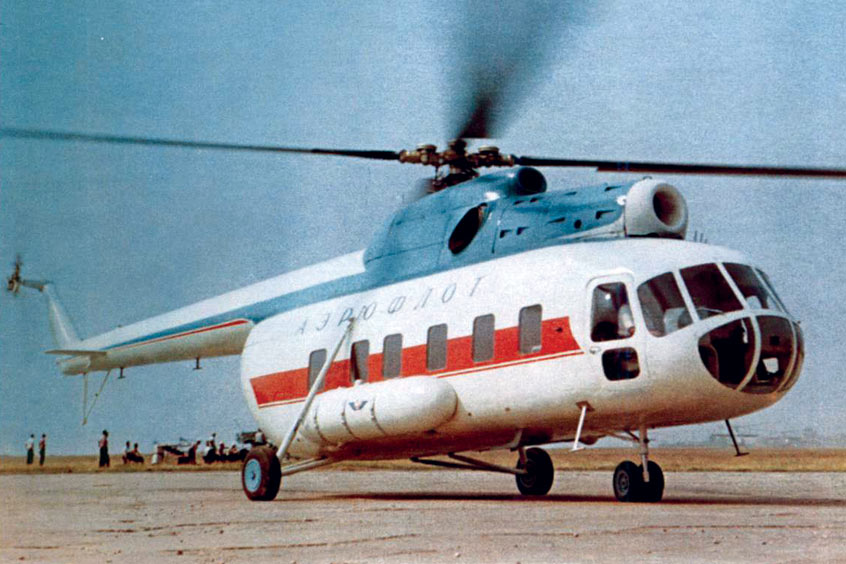ACE 2026 - The home of global charter.
 The bimonthly news publication for aviation professionals.
The bimonthly news publication for aviation professionals.

Sixty years ago, on 24 June 1961, the Mi-8 took off for the first time, becoming one of the most massive twin-engine helicopters in history. It is called the ‘hundred professions’ helicopter, and the ‘eights’ can be seen all over the world with over 13,000 machines having been delivered to more than 80 countries.
The development of the Mi-8 helicopter by Mil OKB specialists began in the second half of the 1950s. Chief designer Mikhail Leontyevich Mil believed that gas turbine engines would make a real revolution in helicopter construction and would increase not only the flight characteristics, but also the economic efficiency of rotary-wing machines, and therefore conceived to equip the new machine with these engines.
In 1958, construction began on the first five prototypes of a new helicopter, which received the working name V-8. Domestic gas turbine engines for helicopters were still being developed at that time, so the first prototypes of the V-8 were single-engine, equipped with an Ivchenko AI-24 aircraft engine, specially modified for installation on a helicopter.
On June 24 1961, the first flight prototype of the V-8 took off after a short hover. The crew was commanded by an experienced test pilot, a veteran of the Great Patriotic War, Boris Vladimirovich Zemskov. Two weeks later, on 9 July, the prototype took part in the aviation parade at Tushino airfield in Moscow flying in a circle. In 1962, the prototype V-8A began flight tests with two TV-2-117 engines specially designed for the helicopter.
The new helicopter was intended to replace the transport Mi-4, but the Mi-8 received a completely different layout as the location of the power plant and the cockpit were actually reversed. Thanks to this solution, a person of average height could walk through the cabin without bending, and the height of the tail boom was sufficient for a car to pass inside the cargo compartment. In the course of development and testing, the new helicopter received more and more differences from the Mi-4: more extensive cockpit glazing, a five-blade propeller and a three-point landing gear. These and other decisions by chief designer Mikhail Mil laid the foundation for the long life of this helicopter. For decades, the Mi-8s have served as virtually the only transport option in remote and inaccessible areas around the world.
In 1965, after making the necessary changes and improvements, the serial production of the new helicopter was deployed at Plant #387 (Kazan Helicopter Plant). The passenger variant was named Mi-8P, and the transport and landing version the Mi-8T. The helicopter quickly became in demand, and in 1970 its production began at the Ulan-Ude Aviation Plant. This is how the long life of the legendary G8 began.
Since then, more than 13,000 civilian and military Mi-8/17s have been built in various configurations, the number of which is approaching 100. This list includes passenger, transport, multipurpose, ambulance, agricultural helicopters, air command posts, electronic warfare helicopters, minelayers and many other modifications. Outstanding flight performance, the ability to work in the most extreme weather conditions, a spacious and comfortable cargo compartment, unpretentiousness and ease of control have ensured the worldwide success of the helicopter.
The design and flight characteristics of the Mi-8 have constantly improved. If during the development it was assumed that the carrying capacity of the helicopter would be two tons, then as the engine power increased, it increased to three to four tons, and on the latest version of the Mi-171A2 it has reached five tons. The development of the Mi-8 family is being continued by Russian Helicopters, a holding of the State Corporation Rostec, and today new engines, avionics, main and tail rotor, navigation systems, as well as the introduction of composite materials allow Mi-8 helicopters to meet the most modern aviation requirements. In the class of civilian heavy helicopters with a maximum take-off weight from 10 to 16 tons, the Mi-8/17 have been holding more than 90 per cent of the world market in quantitative terms for several years.